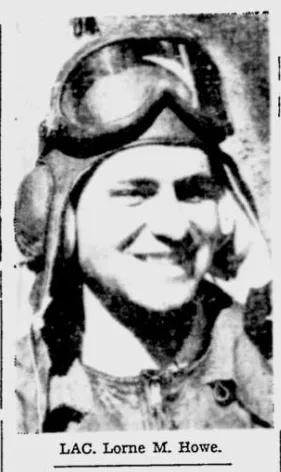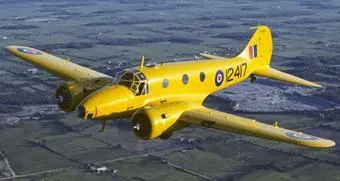Howe, Lorne Meredith (Leading Aircraftman)
Killed in Flying Accident 1944-September-18


Birth Date: 1914
Born:
Parents: Son of Thomas E. Howe and Florence Frances Howe, of Ottawa; husband of Florence Helen Howe, of Ottawa.
Spouse: Husband of Florence Helen Howe, of Ottawa.
Home: Ottawa, Ontario
Enlistment:
Enlistment Date: unkown date
Service
RCAF
Unit
1 AOS- Air Observer School
Base
Malton, Ontario, Canada
Rank
Leading Aircraftman
Position
Navigator
Service Numbers
R/283136
Home
Accident Card - Avro Anson Mk. I / III / IV serial:6385
This accident involved 1 aircraft on 1944-September-18. Anson IV s/n 6385.
This accident involved 5 people. Howe L, Huntington GA, Nikon MV, Troup RH, Williamson GH
This accident had 1 fatality. Leading Aircraftman Lorne Meredith Howe RCAF Killed in Flying Accident service no:R/283136 Anson 6385
Anson serial: 6385

Canadian Warplane Heritage Museum
The Museum's Anson Mk. V was built by MacDonald Brothers in Winnipeg in 1944. It flew with No. 7 Photographic Wing and No. 414 Squadron in Ottawa on photo survey work until the late 1940s. In 1956, it was purchased by INCO and used for mineral surveying until 1980, when it was donated to the Museum. The exterior is painted in the yellow colour common to all BCATP trainers and is in its same wartime RCAF markings.
The Avro Anson was known by a number of nicknames including "Faithful Annie" or "Flying Greenhouse". It was the first aircraft to be flown by the Royal Canadian Air Force to have a retractable undercarriage, which was a comparative novelty in 1936. In 1940, a Canadian government owned company, Federal Aircraft Limited, was created in Montreal to manufacture the Anson for Canadian use. Nearly 3,000 Anson aircraft were produced and, in the early days of the British Commonwealth Air Training Plan (BCATP), the Anson was the standard trainer for many pilots, observers (navigators), wireless operators and bomb aimers. More than 20,000 aircrew received training on the Anson. In Canadian service, the aircraft was substantially re-designed with the substitution of North American engines and many other airframe and equipment changes. Harold Skaarup web pages
Aircraft Images
Anson 6385
Anson Mk. I / III / IV 6385
Ex RAF W1875. To No. 3 Training Command on 24 March 1941, for use by No. 8 Service Flying Training School at Moncton, NB. Category B damage at Moncton aerodrome at 13:00 on 23 October 1941, when Anson 6289 collided with this stationary aircraft. Allocated to Canada Car & Foundry for crash repairs and conversion to Mk. III on 3 November 1941. Arrived there on 5 November 1941, with 549:30 logged time. To No. 1 Training Command on 26 February 1942, for use by No. 16 Service Flying Training School at Hagersville, Ontario. Category C1 damage at Hagersville aerodrome at 17:15 on 12 January 1943. To Central Aircraft at Crumlin, Ontario for crash repairs and modification to Mk. IV on 12 June 1943. To workshop reserve at No. 6 Repair Depot at Trenton on 22 December 1943 for further modifications. To No. 1 Training Command on 20 April 1944, for use by No. 1 Air Observer School at Malton, Ontario. Category A crash while with this School, on 18 September 1944. Ownership to No. 6 Repair Depot on 25 September 1944, pending further instructions.1941-01-30 Taken on Strength Canada Car & Foundry 2019-08-20
1941-October-22 Accident: 8 Service Flying Training School Loc: Aerodrome Names: Peters
1943-January-12 Accident: 16 Service Flying Training School Loc: Aerodrome Names: Card | Mcgeer
1943-June-10 Accident: 16 Service Flying Training School Loc: Cayuga Names: Murray | Shaw
1944-September-18 Accident: 1 Air Observer School Loc: Newcastle Names: Howe | Huntington | Nikon | Troup | Williamson
1944-10-19 Struck off Strength Struck off, reduced to spares and produce 2019-08-20
Unit Desciption
1 AOS (1 Air Observer School)
Air Observers were later called "navigators". For recruits in this stream, the training path after ITS was 8 weeks at an Air Observer School (AOS), 1 month at a Bombing & Gunnery School, and finally 1 month at a Navigation School. The Air Observer schools were operated by civilians under contract to the RCAF. For example, Nos. 7, 8, and 9 were run by CP Airlines. However, the instructors were RCAF. The basic navigation techniques throughout the war years were dead reckoning and visual pilotage, and the tools were the aeronautical chart, magnetic compass, watch, trip log, pencil, Douglas protractor, and Dalton Navigational Computer. They trained in the Avro Anson.
The School was established at Malton, Ontario. The former school is now the Toronto (Pearson) International Airport.
More information on the RCAF Station at Malton can be found at RCAF.info - RCAF Station Malton Ontario